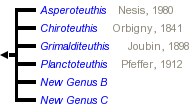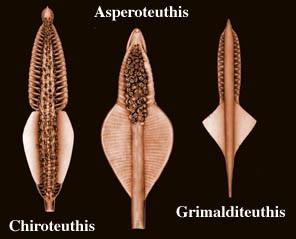Chiroteuthidae
Richard E. Young and Clyde F. E. Roper


This tree diagram shows the relationships between several groups of organisms.
The root of the current tree connects the organisms featured in this tree to their containing group and the rest of the Tree of Life. The basal branching point in the tree represents the ancestor of the other groups in the tree. This ancestor diversified over time into several descendent subgroups, which are represented as internal nodes and terminal taxa to the right.

You can click on the root to travel down the Tree of Life all the way to the root of all Life, and you can click on the names of descendent subgroups to travel up the Tree of Life all the way to individual species.
For more information on ToL tree formatting, please see Interpreting the Tree or Classification. To learn more about phylogenetic trees, please visit our Phylogenetic Biology pages.
close boxIntroduction
Chiroteuthids are small to medium in size (up to 78 cm ML), rather gelatinous, slow moving, deep-sea squids usually with elongate necks and slender bodies. Considerable morphological differences exist among genera, three of which in the past were placed in separate families. However, they all share a very distinctive paralarva known as the doratopsis stage. Members of the family have numerous chambers in the arms, head and mantle filled with a light-weight fluid, ammonium cloride, that provides near-neutral buoyancy for the squids. Most species have extremely long, slender tentacles.
Diagnosis
Member of the chiroteuthid families ...
- with a doratopsis paralarva (unique character).
Characteristics
- Arms
- Arms with suckers in two series.
- Arms with suckers in two series.
- Tentacles
- Club very elongate and divided into two or three portions by symmetrical protective membranes except in Planctoteuthis.
- Club suckers in four series or absent (Grimalditeuthis) in subadults.
- Head
- Head with an elongate neck and usually a brachial pillar in subadults.
- Head with an elongate neck and usually a brachial pillar in subadults.
- Funnel
- Funnel locking-apparatus often oval and with tragus and antitragus.
- Photophores
- Present in some taxa.
- Present in some taxa.
- Paralarva
- Doratopsis type (see Life History).
Comments
The presence of a doratopsis paralarva is the only character that is unique to the family. Additional features of the family include an indistinct eyelid sinus, absence of occipital folds, olfactory organs on long stalks (=slender papillae).
 image info
image info Figure. Medial view of the olfactory organ of Chiroteuthis sp. from Hawaiian waters. Photograph by R. Young.
The following table compares subadults of the five chiroteuthid genera. Subadult characters for genus B, a paralarva, are assumed.
| Character | Planctoteuthis | Chiroteuthis | Asperoteuthis | Grimalditeuthis | Genus B | Genus C |
|---|---|---|---|---|---|---|
| Funnel valve | Absent | Present | Present | Present | ???? | ???? |
| Tentacle pads | Absent | Present | Present | Absent | ???? | Absent? |
| Arm IV photophores | Absent | Present | Absent | Absent | ???? | Absent |
| Arms IV | Variable | Enlarged | Not enlarged | Not enlarged | ???? | ???? |
| Visceral photophores | Absent | Variable | Absent | Absent | ???? | Absent |
| Funnel locking-app. | Antitragus | Tragus & antitragus | Variable | Fused | Antitragus | ???? |
| Arm IV suckers | Absent distally | Present | Present | Present | ???? | ???? |
| Club suckers | Present | Present | Absent proximally | Absent | Present | Present |
| Club sucker series | 4 | 4 | 4 | 0 | 6 | 4 |
Comments
The position of the olfactory papilla is useful in separating genera in the doratopsis stage: The organ lies near the funnel in Grimalditeuthis, just behind the eye in Chiroteuthis and Planctoteuthis and half-way between the funnel and eye in Asperoteuthis.
Nomenclature
Uncertain species:
The taxonomic position of several specimens that anchor species names is uncertain.
- Pfeffer (1912) described a small doratopsis as C. planctonica that he later placed in Planctoteuthis with reservations. The proper placement of this specimen is uncertain.
- Goodrich described a young Chiroteuthis from the Bay of Bengal that he called Doratopsis pellucida. The placement of this specimen is uncertain although it has often been assummed to be the young of C. macrosoma (= C. picteti) (e.g., Nesis 1982), presumably due to the proximity of type localities.
A list of all nominal genera and species in the Chiroteuthidae can be found here. The list includes the current status and type species of all genera, and the current status, type repository and type locality of all species and all pertinent references.
Discussion of Phylogenetic Relationships
The relationships among the genera have not been examined with cladistic methodology. Three genera, however, can be arranged in an ordered series based on the progressive loss of suckers on the tentacular clubs. In Chiroteuthis spp. the oral surface of the club contains suckers in four series throughout its length. In Asperoteuthis spp. the proximal half of the club is bare and the distal half has suckers in four series. In Grimalditeuthis the entire oral surface of the club lacks suckers.
 image info
image info Figure. Oral views of the clubs of Chiroteuthis joubini (left), Asperoteuthis acanthoderma (middle) and Grimalditeuthis bonplandi (right). Drawing from Young, et al. (1999).
Roper and Young (1967) suggested that Planktoteuthis is essentially a mature doratopsis stage, based on features such as the presence in the subadult of the doratopsid tentacular club and the absence of photophores. They suggest, therefore, that the genus arose via neoteny (strong heterochrony). This interpretation gains support from the appearance, then disappearance, of suckers on the tentacular stalks of the paralarva which typically form the secondary club (see Young, 1991). The closest relative to Planktoteuthis among the other genera is unknown.  image info
image info
Figure. Oral view of the doratopsid club of Planctoteuthis sp. A. Drawing from Young (1991).
The distinctive doratopsid club poses a problem: Is this paralarval club similar to the true adult club (i.e., the ancestral adult club) that is absent in the chiroteuthid families? Suckers at the base of the subadult club of Planctoteuthis have a distinctly different structure from those of the remaining club. These basal suckers may represent remnants of a carpal locking-apparatus and, if so, provide an important clue about the relationships of the chiroteuthid families to other oegopsid families.
Unusual features
Doratopsis paralarvae and the adult stages of some species have a gladius that extends well posterior to the fins and supports a remarkable "tail" that bears a variety of ornamentation, mostly of uncertain function. The ornamentation may be in the form of an oval structure superficially resembling a pair of fins, or a series of small flaps and/or oval bulbs. The latter contain anastomosing canals filled with fluid that is lighter than seawater (Hunt, 1996). The overall appearance in some cases is reminescent of a siphonophore (Vecchione, et al., 1992)
Figure. Still frames from a videotape of a doratopsis (left) of Chiroteuthis calyx and the siphonophore Nanomia bijuga (right) recorded in-situ from a remotely operated vehicle (ROV) in the eastern North Pacific off California (courtesy of the Monterey Bay Aquarium Research Institute). An AVI format video clip of this animal can be seen at Cephalopods in Action.
Life history
All species have doratopsis paralarvae (Young, 1991).
The paralarvae live in the upper few hundred meters of the open ocean. They generally reach a very large size (up to 90 mm ML) and undergo a marked but, perhaps, gradual transition to the subadult stage. Among the changes that take place are the resorption of the paralarval tentacle clubs and formation of new clubs along the tentacular stalks, great elongation of the tentacles in most species, development of photophores in some species, loss of the tail in most species and usually a marked change in body proportions. The duration of the doratopsis stage is unknown.
References
Goodrich E. S. 1896. Report on a collection of Cephalopoda from the Calcutta Museum. London, Transactions of the Linnean Society, series 2, 7: 1-24.
Hunt, J. C. 1996. The behavior and ecology of midwater cephalopods from Monterey Bay: Submersible and laboratory observations. Ph. D. Dissertation, Univ. Calif. Los Angeles. 231 pp.
Nesis, K. N. 1982. Abridged key to the cephalopod mollusks of the world's ocean. 385+ii pp. Light and Food Industry Publishing House, Moscow. (In Russian.). Translated into English by B. S. Levitov, ed. by L. A. Burgess (1987), Cephalopods of the world. T. F. H. Publications, Neptune City, NJ, 351pp.
Pfeffer, G. 1912. Die Cephalopoden der Plankton-Expedition. Ergebniss der Plankton-Expedition der Humboldt-Stiftung. 2: 1-815.
Roper, C. F. E. and R. E. Young. 1967. A review of the Valbyteuthidae and an evaluation of its relationship with the Chiroteuthidae. Proc. U.S. Nat. Mus., 123: 1-9.
Vecchione, M., B. H. Robison, and C. F.E. Roper. 1992. A tale of two species: tail morphology in paralarval Chiroteuthis (Cephalopoda: Chiroteuthidae). Proceeding of the Biological Society of Washington 105(4): 683-692.
Verrill, A.E. 1884. Second catalogue of the Mollusca, recently added to the fauna of the New England coast and the adjacent parts of the Atlantic, consisting mostly of deep-sea species, with notes on others previously recorded. Trans. Connecticut Academy Sciences, 6: 133-294.
Young, R. E. 1991. Chiroteuthid and related paralarvae from Hawaiian waters. Bull. Mar. Sci., 49: 162-185.
Young, R. E., M. Vecchione and D. Donovan. 1998. The evolution of coleoid cephalopods and their present biodiversity and ecology. South African Jour. Mar. Sci., 20: 393-420.
About This Page
Richard E. Young
Dept of Oceanography
University of Hawaii
Honolulu, Hawaii 96822
USA
Page copyright © 1998 Richard E. Young and
Citing this page:
Young, Richard E. and Roper, Clyde F. E. 1998. Chiroteuthidae . Version 01 January 1998 (under construction). http://tolweb.org/Chiroteuthidae/19451/1998.01.01 in The Tree of Life Web Project, http://tolweb.org/





